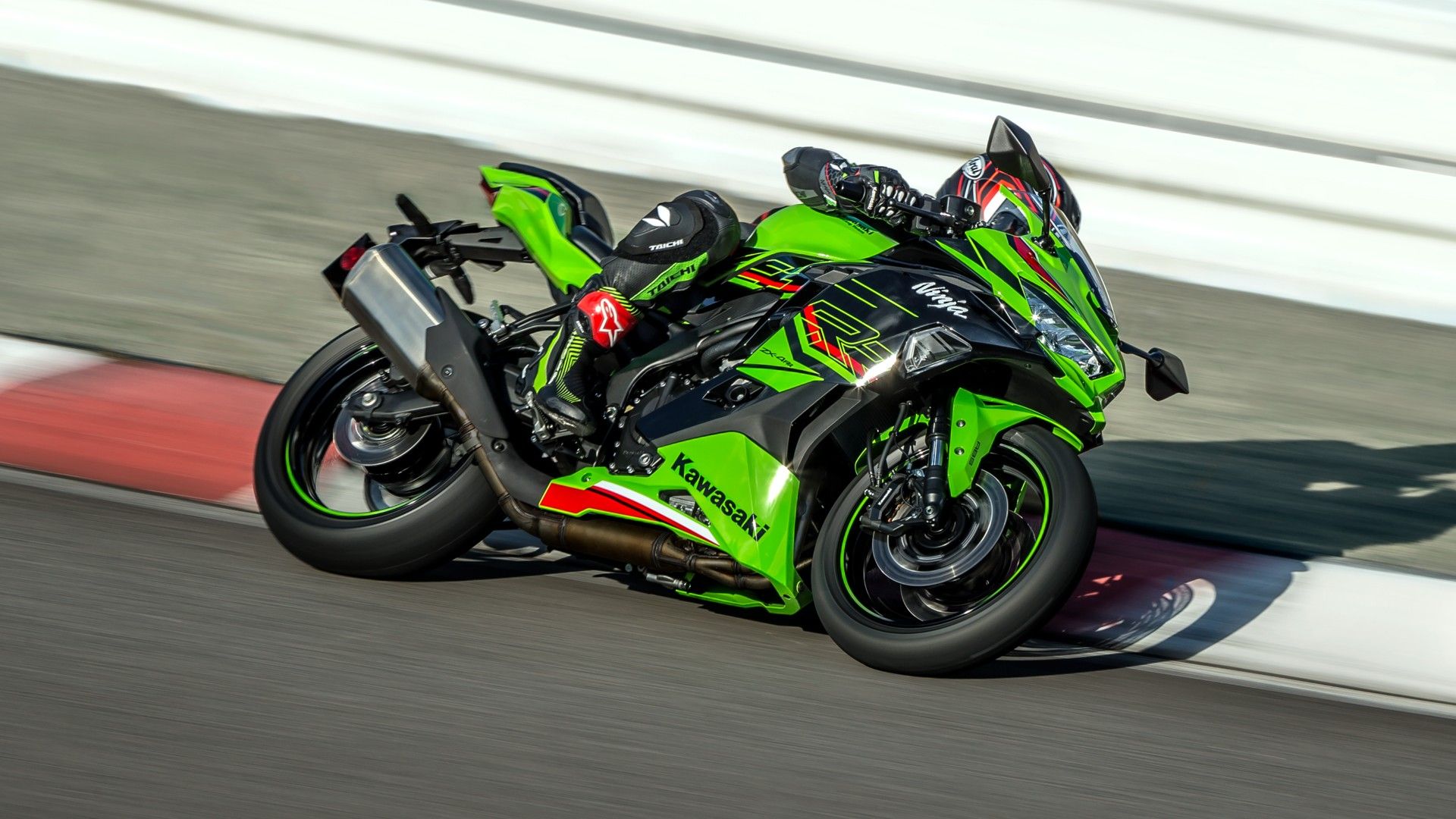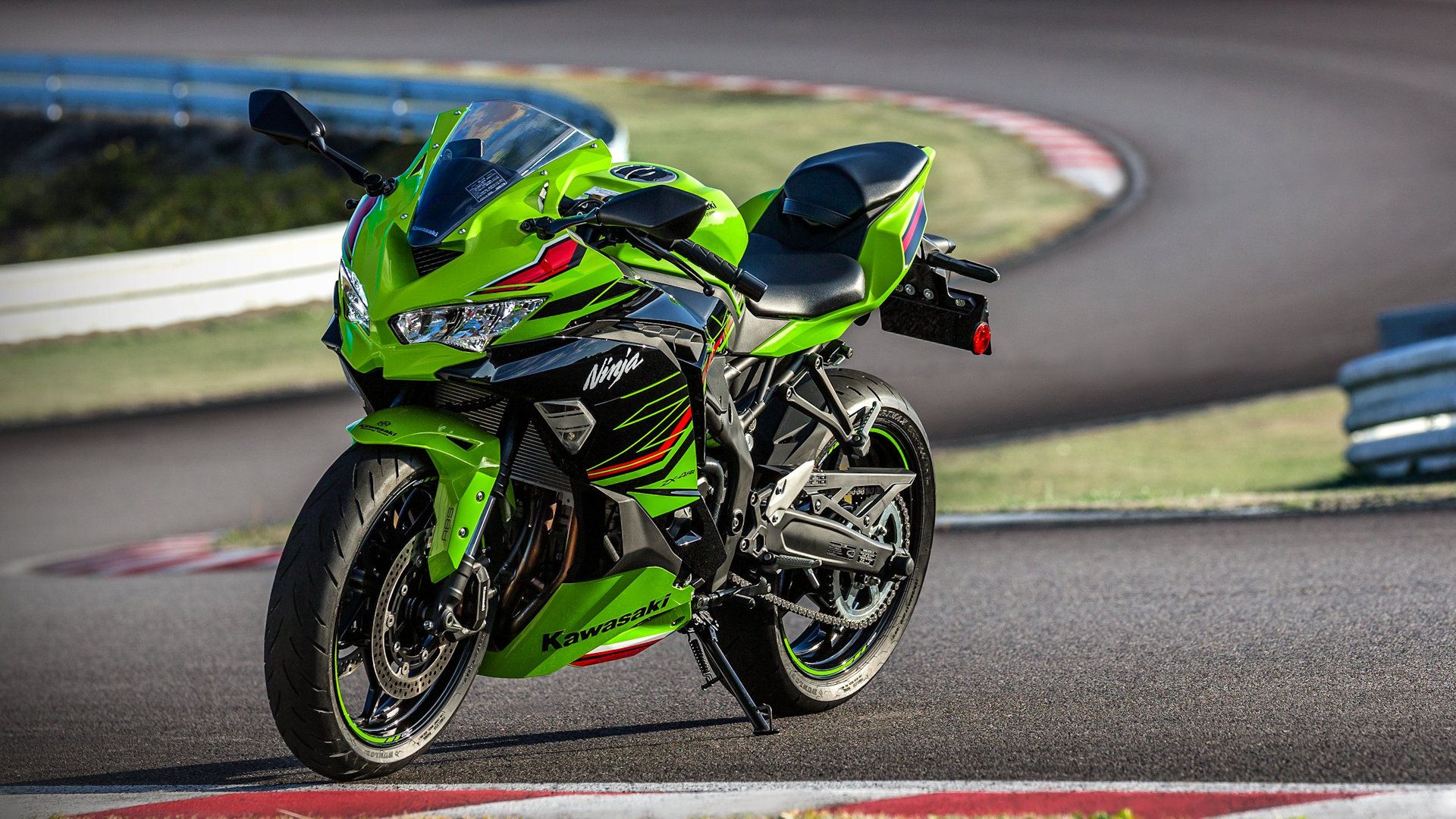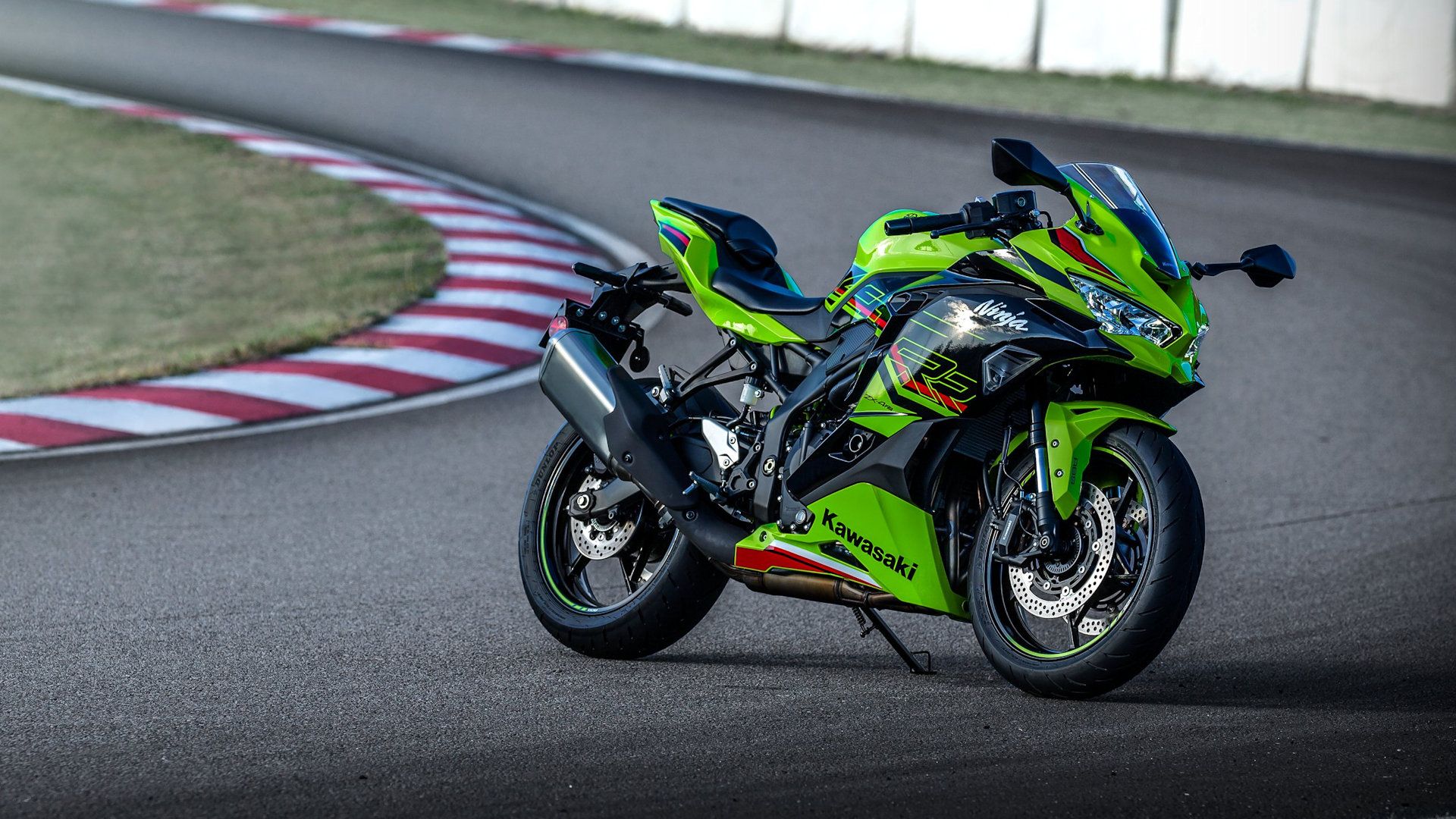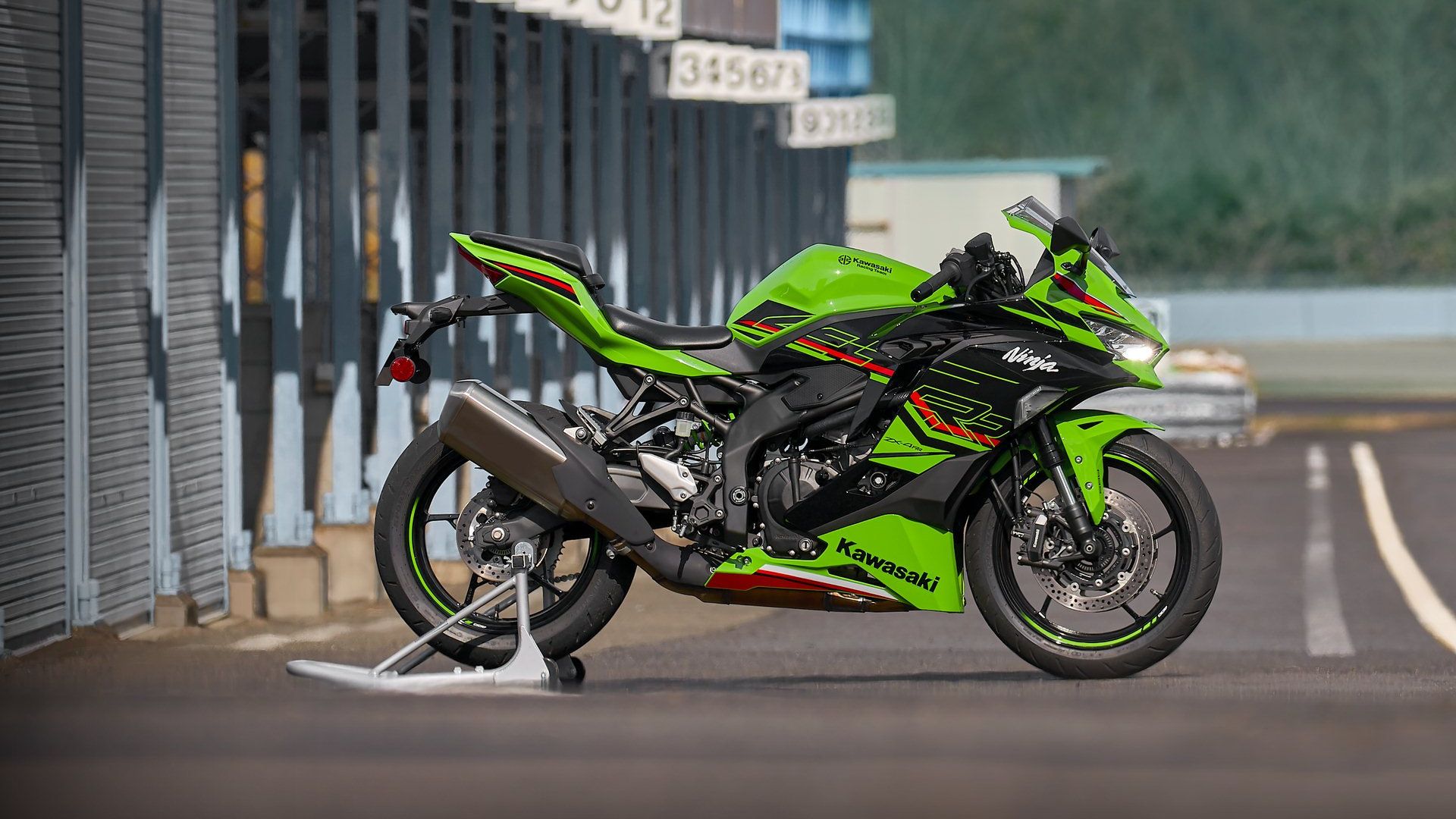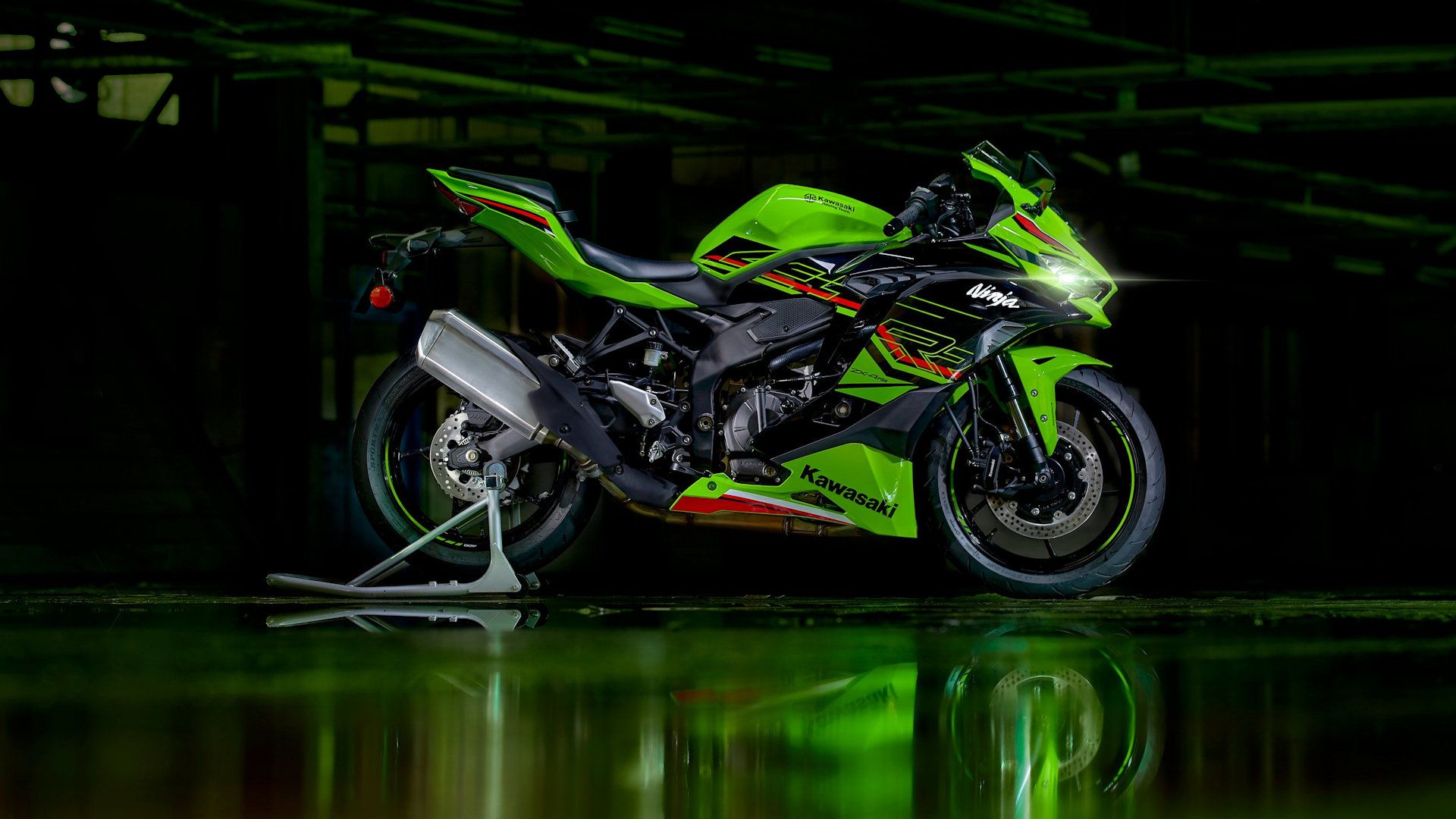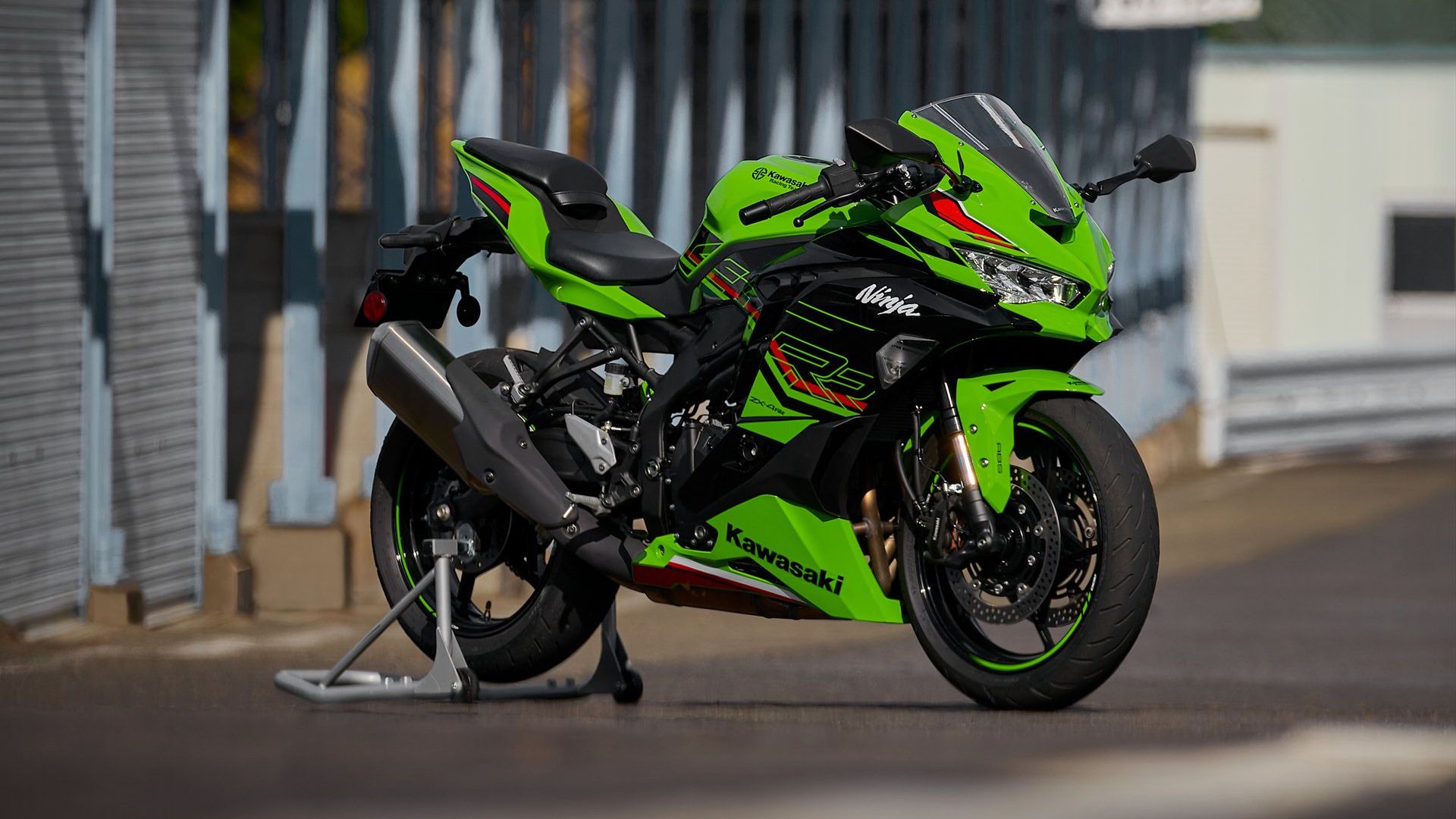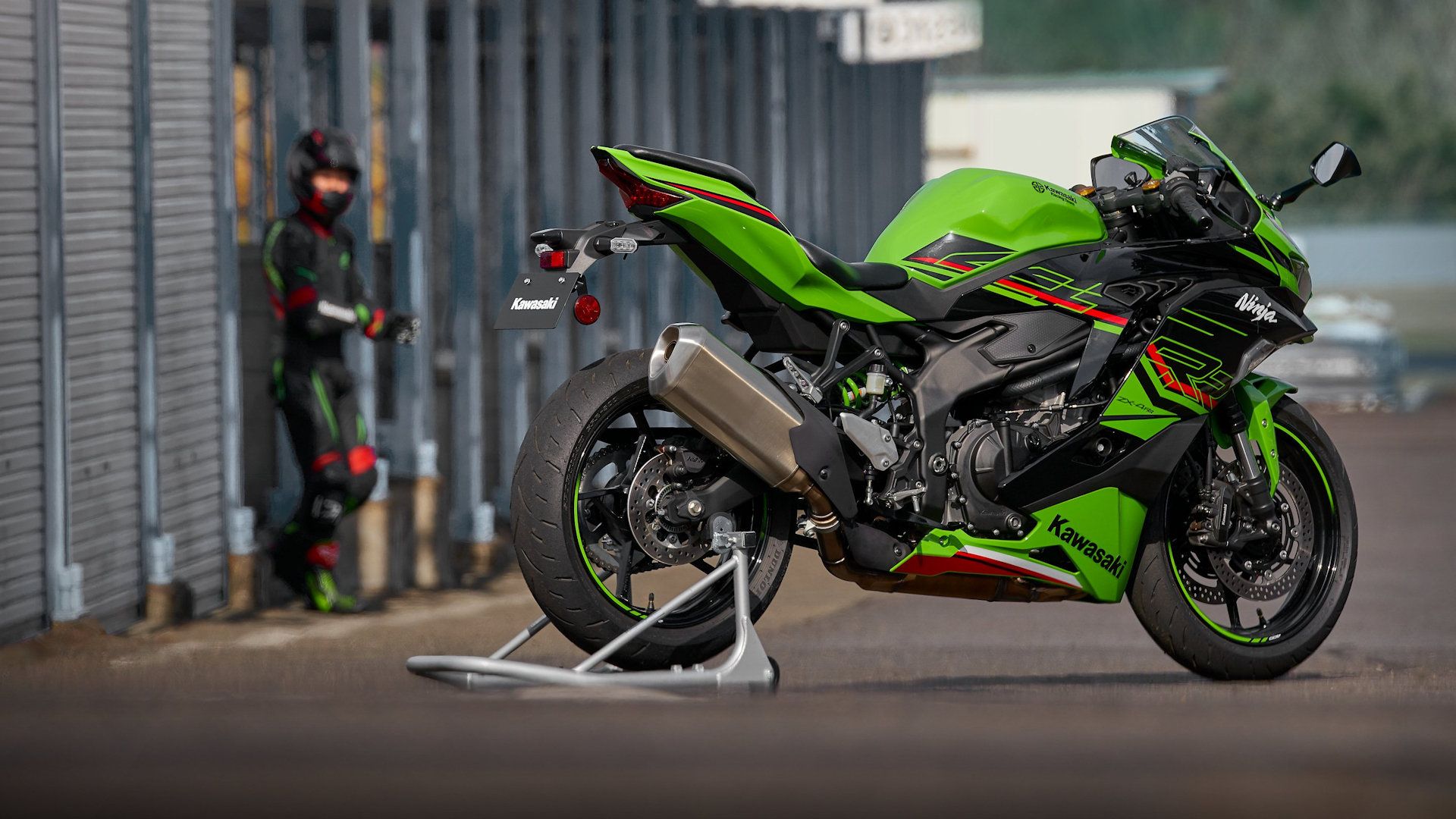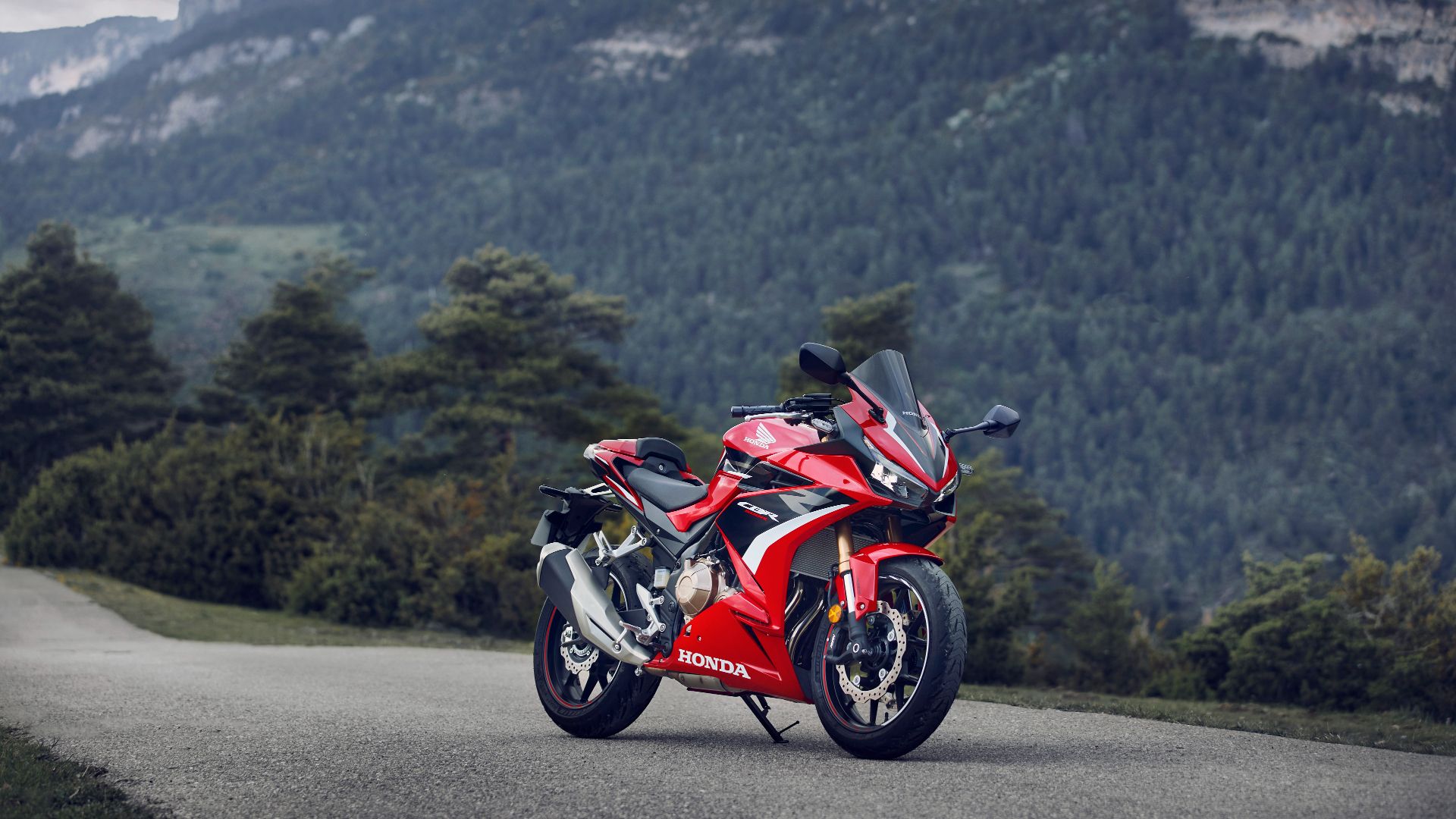Kawasaki brings superbike-level yummygoodness down to the supersport-level bracket with its 2023 Ninja ZX-4RR KRT. The factory hit its little-big bike Ninja with a major update this year to make it qualify as a “new” bike, at least on paper.
A new, superbike-inspired frame comes with new, top-shelf suspension goodies and new brake hardware to haul it down. The cockpit has a new instrument display and improved ergonomics for a more natural body position and greater comfort than before.
A new smartphone connection unlocks the Rideology The App feature that brings an uncommon level of infotainment delightfulness for such a small engine displacement. LED tech adds to the two-way visibility, and a new quick-shift feature joins with a new, integrated ride modes system to complete the MY2023 package. It all comes wrapped in Kawi's race-tastic KRT livery to set the tone.
2023 Kawasaki Ninja ZX-4RR
- All-New 399 cc High-Revving Engine
- Race-Developed Assist And Slipper Clutch
- Ninja® ZX™-10RR-Derived Chassis Geometry
- Quick Flicks And Reversals
- 4.3-inch Full-Color TFT Display
- Model: Ninja ZX-4RR
- Engine:: 399 cc
- Power Output: 76 @ 14,500 RPM
- Torque: 27.5 LB-FT @ 12,500 RPM
- Transmission: 6-speed manual
- MSRP: $9,699
- Excellent Performance For Its Size
- Top-Shelf Electronics
- Solid Underpinnings
- Too Fast To Get The Most On Public Roads
- Front Forks Are Preload Adjustable Only
- A Choice In Paint Would Be Nice
2023 Kawasaki Ninja ZX-4RR Performance And Capability
The factory built a new, liquid-cooled, in-line four-banger for the ZX-4RR KRT. It rides transverse in the frame but isn't so bulky that it fattens up the cowling. This leaves the engine compartment quite narrow reducing drag and improving penetration for high-speed performance and acceleration.
A 57 mm bore and 39.16 mm stroke give it a 399 cc displacement and a sizzlin' hot, 12.6-to-1 compression ratio. That high compression demands top octane road champagne to prevent knock/ping/dieseling, and the associated damage those conditions can cause to an engine. The Kawasaki Ninja ZX-4RR KRT produces 76 horsepower and 27.5 pound-feet of torque with a top speed of 157 MPH according to the release in Indonesia.
A quartet of 34 mm throttle bodies maintain the stoichiometric air-fuel mixture and feed the beast through 22.1 mm intake valves with 19 mm poppets on the exhaust side. Dual over-head cam times the 16-valve head, and triple-rate valve springs close the valves. This system limits the tendency to enter a harmonic valve-float state at high rpm preventing the valves and piston crowns from occupying the same place at the same time. A narrow valve-to-seat angle aids in the flow dynamics at both sets of mushroom valves.
The lightweight aluminum piston contributes minimal mass to the reciprocating weight and comes with molybdenum-infused skirts to lower mechanical losses due to piston-to-cylinder drag. Additionally, the piston crowns come with a new design that boosts compression in conjunction with the shape of the combustion chamber. The connecting rods and wrist pins benefit from carburizing treatment that improves service life by reducing friction.
Power flows through a slipper-type clutch that delivers a light pull at the lever, an easily controllable friction zone, and effective back-torque mitigation to prevent rear-wheel hop. The six-speed transmission does its thing and comes with the Kawasaki Quick Shift feature that lets you bang your way both up and down the range with nary a touch of the clutch lever nor a roll-off at the throttle. Integrated Riding Modes and Power Modes let you dial in power delivery with a Traction Control feature to round out the electronics.
Design
Kawi drew on its own superbike experience for the ZX-4RR build, and there's more going on than immediately meets the eye. A vented and molded fender leads the way with a shape that helps pull air down and into the radiator that rides just behind to improve waste-heat dissipation. The engine cowl covers from the front fairing down to the belly pan with a prominent scoop that extends forward to almost swallow the front end in its entirety.
Dual, LED headlights dominate the face below a ram-air duct that feeds pressurized air from the front of the bike directly into the downdraft intake tract for a low-budget boost to performance. Unfortunately, the effect is negligible until up around the 100 mph mark, so it's reduced to a conversation piece outside a racetrack proper.
A small bubblescreen tops off the fairing for the rider's pocket, though you'll have to put the chin on the tank to find it. The good news is, the clip-on handles are dead short and encourage an aggressive, forward-leaning riding posture, so you're already almost there already.
Deep knee pockets in the four-gallon fuel tank give it a narrow tail where it meets the equally narrow seat and waist juncture to give your legs a straight shot to the ground from the 31.5-inch tall saddle. This will be confidence-inspiring at stops and when padding around in the parking lot.
There's room for a very brave friend on the lofted pillion pad, but comfort is not a front-burner issue, coming in after race-style looks, minimal weight, and low windage. The LED taillight rides at the tip of the tail with the rest of the gear in the rear – blinkers, license plate, and tag light – mounted on a short mudguard. Kawi doesn't say so up front, but I expect that the factory has removal kits that let you strip the mudguard and mirrors off ahead of track days.
Kawasaki Ninja ZX-4RR Specs | |
|---|---|
Length | 78.4 in |
Width | 30.1 in |
Height | 43.7 in |
Seat Height | 31.5 in |
Wheelbase | 54.3 in |
Ground Clearance | 5.3 in |
Fuel Capacity | 4.0 gal |
Curb Weight | 414.5 lb |
Chassis
High-tensile steel is the material of choice for the Trellis-style frame. The tubing used throughout has variable wall thickness to strike a balance between strength, weight, and flexion; the same with the asymmetrical swingarm that has one straight bar and one gull-wing member to complete the framework.
An uncommonly steep steering head angle of only 23.5 degrees couples with a dead-short, 3.8-inch trail figure for a very willing nature in the corners with quick flicks and reversals. The inverted Showa front forks have a 37 mm inner tube diameter with 4.7 inches of travel ahead of a Horizontal-Link rear shock that rocks the full trifecta of tweaks and has 4.9 inches of travel to make this bike comfortable in the grittiest of urban jungles and on the backroads alike.
Cast-alloy, 17-inch wheels mount a 120/70 and 160/60 on the front and rear respectively. Dual, 290 mm discs and four-bore Brembo Monobloc binders handle the heavy braking, while out back, a 220 mm disc and single-pot anchor keep the rear end behind you where it belongs. Nissin ABS protection comes in a compact, lightweight package to complete the electronics suite.
Chassis & Suspension | |
|---|---|
Frame | Trellis, high-tensile steel |
Front Suspension/ Travel | 37mm inverted fork with SFF-BP internals and spring preload adjustability/ 4.7 in. |
Rear Suspension/ Travel | Horizontal Back-link, BFRC lite gas charged shock w/ piggyback reservoir, adjustable compression, rebound and spring preload/ 4.9 in. |
Rake | 23.5° |
Trail | 3.8 in |
Front Tire | 120/70 - 17 |
Rear Tire | 160/60 - 17 |
Front Brake | Dual 290 mm discs, ABS |
Rear Brake | 220 mm disc, ABS |
2023 Kawasaki ZX-4RR Price And Availability
The 2023 Kawasaki Ninja ZX-4RR KRT costs $9,699. As the name suggests, it's only available in the Kawasaki Race Team livery for its inaugural year.
Pricing & Features | |
|---|---|
Features | Traction Control, Quick Shifter, Power Modes, ABS, Smartphone Connectivity, TFT Display |
Warranty | 12-Month Limited Warranty |
Colors | Lime Green/Ebony |
Price | $9,699 |
Competitors
None of the Big Four have a direct competitor here, but Honda gets close with its CBR500R. The engine is a skosh larger at 471 cc total displacement with an almost-square layout of 67 mm by 66.8 mm and a milder, 10.7-to-1 compression ratio that may tolerate mid-grade gas. At the shaft, the engine produces 50 horsepower and 31.7 pound-feet of torque in a tradeoff against the 77.6/26.5 from the Ninja, due to the parallel-twin configuration on the Honda.
Suspension is a wash, as are the brakes as ABS comes stock across the board. Honda offers its bike with a choice between Grand Prix Red and Sword Silver Metallic for $7,299, so you could save some money, but the performance and electronic yummygoodness of the Ninja make it a lot more bike and worth the extra cheddar.
He Said
“This is NOT your usual 400 cc-ish machine. The capabilities and electronics it brings to the table are more like closer to liter-bike territory, to be honest. However, if you are looking for a bike you can race on closed courses or drag strips and be competitive right off the showroom floor, look no further.”
She Said
My wife and fellow motorcycle writer, Allyn Hinton, says,
“Kawasaki is looking at three versions of the ZX-4: the base model 4R, the 4R SE, and the 4RR. Kawasaki announced only the 4RR for release so far, but we should see the other two in markets outside the U.S. next year.”
“Suspension differs between the 4R and the 4RR, as you might expect. The base model is fairly vanilla whereas the 4RR front forks have only preload adjustability. That's a little disappointing, but overall it's a snazzy mid-displacement bike that will be in good company with the likes of the Yamaha YZF-R3 and Honda CBR500R.”
FAQ
Q: How much horsepower and torque does a Kawasaki Ninja ZX-4RR have?
According to rideapart.com, the ZX-4RR released in Indonesia produces 76 horsepower and 27.5 pound-feet of torque with a top speed of 157 MPH. Figures on the U.S. release come in close at 77.5 horsepower and 26.5 pound-feet of torque.
Q: Is Kawasaki releasing ZX-4R?
At the time of this writing, we're looking at a 2024 release of the Ninja ZX-4R and ZX-4R SE in markets outside the U.S. market.
Q: How much is a 2023 ZX4RR?
MSRP on the 2023 Kawasaki Ninja ZX-4RR KRT is $9,699 in the U.S. market.
Q: What engine is in a ZX-4RR?
Kawasaki powers the Ninja ZX-4RR with a new, 399 cc liquid-cooled inline-four-cylinder engine.

